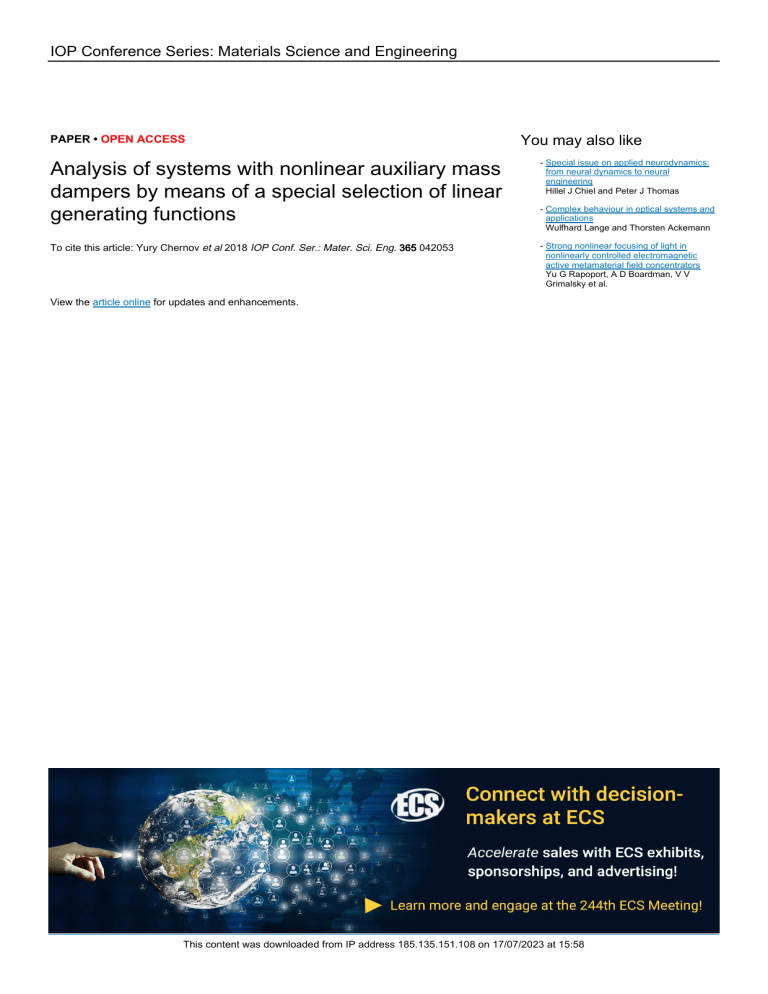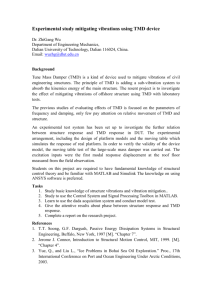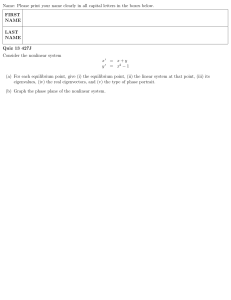
IOP Conference Series: Materials Science and Engineering PAPER • OPEN ACCESS You may also like Analysis of systems with nonlinear auxiliary mass dampers by means of a special selection of linear generating functions - Special issue on applied neurodynamics: from neural dynamics to neural engineering Hillel J Chiel and Peter J Thomas To cite this article: Yury Chernov et al 2018 IOP Conf. Ser.: Mater. Sci. Eng. 365 042053 - Strong nonlinear focusing of light in nonlinearly controlled electromagnetic active metamaterial field concentrators Yu G Rapoport, A D Boardman, V V Grimalsky et al. - Complex behaviour in optical systems and applications Wulfhard Lange and Thorsten Ackemann View the article online for updates and enhancements. This content was downloaded from IP address 185.135.151.108 on 17/07/2023 at 15:58 FORM 2018 IOP Publishing IOP Conf. Series: Materials Science and Engineering 365 (2018) 042053 doi:10.1088/1757-899X/365/4/042053 1234567890‘’“” Analysis of systems with nonlinear auxiliary mass dampers by means of a special selection of linear generating functions Yury Chernov, Maria Volkova and Mohammed Zebilila Moscow State University of Civil Engineering, Yaroslavskoe shosse, 26, Moscow, 129337, Russia E-mail: marissa36@yandex.ru Abstract. Nonlinear vibration isolation systems have a wider range of effective damping than linear ones. However, their analysis with an arbitrary load is quite laborious. In the article the method of special selection of linear generating systems for analyzing nonlinear systems proposed by professor Chernov Yu T is used. The linear generating system is chosen in such a way that the difference between the solutions of the linear and nonlinear systems in the first approximation for the first harmonic is minimal. Such an approach makes it possible to reduce the complexity of constructing the amplitude-frequency characteristics of nonlinear systems. In this paper, the amplitude-frequency characteristics were constructed to evaluate the efficiency of nonlinear auxiliary mass dampers at different frequencies of the external load. Tuned mass damper (TMD) was chosen as the type of auxiliary mass damper. The article looks at numerical examples of two systems with nonlinear TMD as a three degrees of freedom system. In the first numerical example, a stand with an equipment installed on it was analyzed. The TMD is installed on the stand. In the second numerical example the equipment is installed on a pedestal. The equipment is equipped with a nonlinear TMD. In both examples, there is cubic reaction-displacement relationship in the link that attaches the TMD. The amplitude-frequency characteristics for both systems are constructed for different variants: with a nonlinear, linear TMD and without a damper. The linear TMD was tuned to the first natural frequency of oscillations of the system without a damper. A comparative analysis of the options is given. The efficiency of using nonlinear TMD is determined from the numerical examples. There is a three times reduction in displacements in the nonlinear system as compared to the linear system. 1. Introduction Nonlinear vibration isolation systems have been found to be more effective in vibration isolation than linear ones [1,2,3,4]. Various descriptions of nonlinear isolation systems could be found in [5]. Tuned mass damper (TMD) was chosen as the type of auxiliary mass damper. TMD have been used over many years to protect structures from the negative effects due to vibration. Optimum tuning parameters of TMD were given by Den Hartog [6] and in [7]. In this study the efficiency of a TMD with a nonlinear link between the structure and the TMD (nonlinear TMD) is assessed using the method of special selection of linear generating systems for analyzing nonlinear systems proposed by Prof. Chernov Yu T [8]. Content from this work may be used under the terms of the Creative Commons Attribution 3.0 licence. Any further distribution of this work must maintain attribution to the author(s) and the title of the work, journal citation and DOI. Published under licence by IOP Publishing Ltd 1 FORM 2018 IOP Publishing IOP Conf. Series: Materials Science and Engineering 365 (2018) 042053 doi:10.1088/1757-899X/365/4/042053 1234567890‘’“” The linear generating system is chosen in such a way that the difference between the solutions of the linear and nonlinear systems in the first approximation for the first harmonic is minimal. Such an approach makes it possible to reduce the complexity of constructing the amplitude-frequency characteristics of nonlinear systems. The amplitude-frequency characteristics were constructed to evaluate the efficiency of nonlinear TMD at different frequencies of the external load. The article looks at numerical examples of two systems with nonlinear TMD as the three degrees of freedom systems. 2. Numerical examples 2.1. First numerical example In the first numerical example (figure 1), a system with 3 degrees of freedom was selected, representing a stand (mass m2) with dynamic equipment (mass m1) installed on it. The mass m3 in this system is a nonlinear TMD. Figure 1. Calculation scheme of 2 degrees of freedom system with a TMD The equations of motion of such system have the form: d 2 x1 d2 t d m 1 2 k x x m ; 1 2 1 1 1 1 2 2 d t d t d t d 2 x d2 t d d d 2 ; m2 2 1 21 k1 x1 x2 1 2 2 k2 x2 1 23 c3 x2 x3 m2 dt dt dt dt dt 2 d2 x d m3 23 1 2 3 c3 x2 x3 0, d t d t (1) where m1, m2, m3 – masses of elements of the system; k1, k2, c3 – stiffness of elements of the system; x1, x2, x3 – horizontal displacements of elements of the system; 1, 2, 3 – damping coefficients of the system; t – function of ground motion. The reaction in the link connecting the TMD is determined in accordance with the equation: c3 x2 x3 kn 1 x2 x3 2 x 2 x3 . (2) The characteristics of the system under consideration are as follows: m1 = 1 t; m2 = 10 t; m3 = 1 t; k1 = 30·103 kN/m; k2 = 58·103 kN/m; kn = 5000 kN/m; α = 40. In accordance with the method of special selection of generating linear system proposed by Prof. Chernov Yu T [8], we denote the stiffness of the TMD in the generating system by kd. Then the equations of motion of generating linear system take the form: 2 FORM 2018 IOP Publishing IOP Conf. Series: Materials Science and Engineering 365 (2018) 042053 doi:10.1088/1757-899X/365/4/042053 1234567890‘’“” d 2 x1 d2 t d m 1 2 k x x m ; 1 2 1 1 1 1 2 dt dt 2 dt d 2 x d2 t d d d 2 (3) ; m2 2 1 21 k1 x1 x2 1 2 2 k2 x2 1 23 kd x2 x3 m2 dt dt dt dt dt 2 d2 x d m3 23 1 2 3 kd x2 x3 0, dt dt In the first approximation, the displacements of masses are determined by the following formulas: (4) xi ,1 t xi ,0 t hi t , 3 t where hi t f j t Vij t d , (5) j 1 0 where, after neglecting damping components we have: f1 t 0 ; f 2 t c3 x2 x3 kd x2 x3 kn kd x2 x3 kn x2 x3 ; (6) f3 t f 2 t . (7) 3 With zero initial conditions and with the function of ground motion displacement in the linear generating system xi ,0 t takes the form: d2 t dt 2 0 sin t (8) xi ,0 t X i ,0 sin t . The matrix equation of motion of system (3) has the form: k1 m12 k1 0 m10 2 (9) A k k1 k2 kd m2 kd ; B m20 . 2 0 kd kd m3 0 Solving the linear system, we obtain the following expressions for the displacements of masses xi ,0 t without taking damping into account: xi ,0 t 0Ci D sin t ; where C1 m1 k1 k2 kd m22 kd m32 kd2 m2 k1 kd m32 ; C2 kd m32 m1k1 m2 k1 m32 ; (10) (11) (12) C3 kd m1k1 m2 k1 m32 ; (13) D D1kd D0 , (14) D – the determinant of the system (3), equals where D1 k1 m12 k1 k2 m22 m32 k12 ; (15) D0 [ k1 m12 k1 k2 m22 k12 ]m32 . (16) The function f 2 t takes the form: f 2 t k n kd 0 С D sin t kn 30 С 3 3sin t sin 3t , D 3 4 where С C2 С3 m32 [m1k1 m2 k1 m12 ] . 3 (17) (18) FORM 2018 IOP Publishing IOP Conf. Series: Materials Science and Engineering 365 (2018) 042053 doi:10.1088/1757-899X/365/4/042053 1234567890‘’“” In accordance with the method based on the special selection of generating systems, we equate the coefficients of the fundamental harmonic sin t in f 2 t to zero. After simplification, we obtain the following equation: 4D12 kd3 4D1 2D0 D1 kn kd2 4D0 D0 2D1kn kd 4D02 kn 3kn 02 С 2 0 (19) The algorithm for constructing the amplitude-frequency characteristic is as follows. For any values of frequency ω and amplitude 0 of the excitation force, the corresponding optimum stiffness of the generating system kd (from equation (19)) is determined, the solution of which gives the minimum error with respect to the initial nonlinear system. Then, the amplitudes of mass oscillations (taking damping into consideration) of the system are determined by the formula ([8], [9]): 3 C p Rs (i = 3), (20) X i ,0 0 i s 2 B s 1 ps As where B m1m2 m3 p32 p22 p 2 3 p12 p22 p12 ; Ci ps – using formulas (11)–(13); ps – natural frequencies of the system (9); R s p12 Rem( s ,3) p12Rem( s 1,3) ; Rem s,3 – the remainder of dividing the number of the normalized eigenform s by 3; As 1 2 / ps2 2s 2 1/2 ; s – damping coefficients corresponding to normalized eigenforms. Amplitude of ground acceleration 0 1 m / s 2 . The amplitudes of displacement of mass m3 are shown in figure 2. The amplitude-frequency characteristic for the system without TMD is also constructed . Figure 2. Amplitude-frequency characteristics for the lower masses of systems: with TMD (blue solid line); without damper (red dotted line). Since according to the existing practice, TMD is usually tuned to the first frequency of the system without a damper, then we will evaluate their efficiency by comparing the amplitudes of the lower mass of the system with and without the damper. For the system under consideration, this frequency is 4 FORM 2018 IOP Publishing IOP Conf. Series: Materials Science and Engineering 365 (2018) 042053 doi:10.1088/1757-899X/365/4/042053 1234567890‘’“” 71.9 rad/s. When using a nonlinear TMD, the amplitude of displacements of the lower mass at this frequency decreases by 3.1 times. 2.2. Second numerical example In the second numerical example, we considered a system with 3 degrees of freedom, the design scheme of which is shown in figure 3. The system is a stand (mass m3) on which an equipment (mass m2) with a nonlinear TMD m1 is installed. The characteristics of the system are as follows: m1 = 1.5 t; m2 = 8 t; m3 = 15 t; k2 = 20·103 kN/m; k3 = 90·104 kN/m; kn = 10·103 kN/m; α = 40. Figure 3. Calculation scheme of 3 degrees of freedom system The reaction in the link connecting the TMD is determined by the expression: c1 x1 x2 kn 1 x1 x2 2 x x . 1 (21) 2 The steps of solving is similar to the solution in the first numerical example. We denote the stiffness of the TMD in the generating system by kd. The equations of motion of the generating linear system will have the form: d 2 x1 d 2 t d m 1 2 k x x m ; 1 2 1 1 d 1 2 dt dt 2 dt d 2 x d 2 t d d 2 (22) . m2 2 1 21 k1 x1 x2 1 2 2 k2 x2 x3 m2 dt dt dt dt 2 d2x d 2 t d d m3 23 1 2 2 k2 x2 x3 1 2 3 k3 x3 m3 , dt dt dt dt 2 In the first approximation, the masses are determined by the formulas (4). Functions fi t have the form: f1 t c1 x1 x2 kd x1 x2 x1 x2 kn kd kn x1 x2 ; f 2 t f1 t ; (23) (24) f3 t 0 . The displacements in the system with harmonic external action are determined by formula (10), where in accordance with the formulas obtained by M.V. Volkova in [9], the formulas for Ci have the following forms: C1 m1 kd k2 m22 k2 k3 m32 k22 m2 kd k2 k3 m32 m3kd k2 ; (25) 3 C k k m m k m k m m k k m ; C k m k m k m m k m k k m k 2 2 2 3 3 1 d 2 2 1 d 2 d 2 1 3 2 2 3 2 d 1 d 2 3 1 1 D – is determined by formula (14), in which 5 2 d (26) 1 2 2 2 d ; (27) FORM 2018 IOP Publishing IOP Conf. Series: Materials Science and Engineering 365 (2018) 042053 doi:10.1088/1757-899X/365/4/042053 1234567890‘’“” D1 k2 k3 m32 k2 m1 m2 2 k22 ; (28) D0 m12 k2 k3 m32 k2 m22 k22 . (29) the function f1 t takes the form of (17), where (30) С C1 С2 m1k2 k3 . The optimum stiffness of the damper in the linear generating system is determined for each angular frequency ω by equation (19), where С is determined by formula (30). The amplitudes of mass oscillations of the system are determined by formula (20), where Ci ps is calculated from formulas (25) – (27); formulas for the remaining variables are as defined in formula (20). The amplitude of ground acceleration is taken as 0 1 m / s 2 . The obtained amplitudes of displacements of mass m3 are shown in figure 4. Figure 4. Amplitude-frequency characteristics of systems: with TMD (solid line); without damper (dotted line) For the system under consideration, the first natural frequency of oscillations of the system without an absorber is 77.5 rad/s. When using a nonlinear TMD, the amplitude of displacements of the lower mass at this frequency decreases by 4.1 times. 3. Conclusion In analyzed numerical examples there is a three times reduction in displacements in the nonlinear system using tuned mass dampers as compared to the linear systems. References [1] Ivovich V A Vibroizolirovannyye sistemy s nelineynymi kharakteristikami [Vibration isolated systems with non-linear characteristics]. Moscow: Stroyizdat, 1984. [2] Lang Z Q, Jing X J, Billings S A, Tomlinson G R, and Peng Z K, "Theoretical study of the effects of nonlinear viscous damping on vibration isolation of sdof systems," Journal of Sound and Vibration, No. Volume 323, Issues 1–2, 2009. pp. pp 352-365. 6 FORM 2018 IOP Publishing IOP Conf. Series: Materials Science and Engineering 365 (2018) 042053 doi:10.1088/1757-899X/365/4/042053 1234567890‘’“” [3] [4] [5] [6] [7] [8] [9] Lu Z, Brennan M J, Yang T, Li X, and Liu Z, "An investigation of a two-stage nonlinear vibration isolation system," Journal of Sound and Vibration, No. volume 332, Issue 6, 2013. pp. pp 1456-1464. Soong T T, Constantinou M C Passive and active structural vibration control in civil engineering. New York: Department of Civil Engineering State University of New York at Buffalo, 1994. Ibrahim R A, "Recent advances in nonlinear passive vibration isolators," Journal of Sound and Vibration, No. Volume 314, Issues 3–5, 2008. pp. pp 371-452. Den Hartog J P Mechanical Vibrations. 4th ed. New York: Dover Publications, 1956. Rizzi E, Brescianini D, and Scotti M On the optimal tuning of Tuned Mass Dampers in structural system // ECCOMAS Thematic Conference on Computational methods in Structural Dynamics and Earthquake in Engineering (COMPDYN). Rhodes, Greece. 2009. Chernov Yu T Vibratsii stroitel'nykh konstruktsiy. (Analiticheskiye metody rascheta. Osnovy proyektirovaniya i normirovaniya vibratsiy stroitel'nykh konstruktsiy, podvergayushchikhsya ekspluatatsionnym dinamicheskim vokhdeystviyam). [Vibration of building structures. (Analytical Calculation Methods: The Basics of Designing and Normalizing Vibrations of Building Constructions Undergoing Operational Dynamic loads)]. 2nd ed. Moscow: Publisher ASV, 384 p, (2011). Osipova M V Raschet vibroizolirovannykh sistem na dinamicheskiye nagruzki s ispol'zovaniyem peredatochnykh funktsiy [Calculation of vibration-isolated systems for dynamic loads using transfer functions], Seismic construction. Safety of buildings. No. 4. pp. 18-20, (2013). 7






